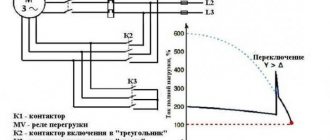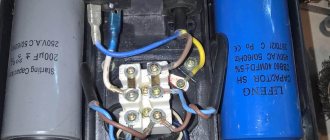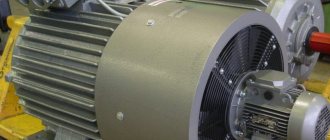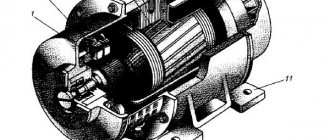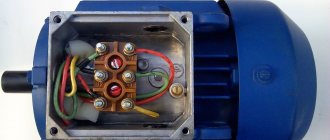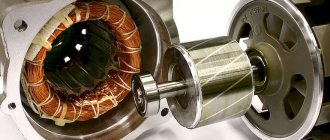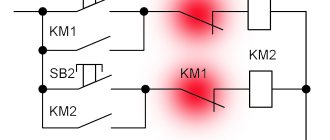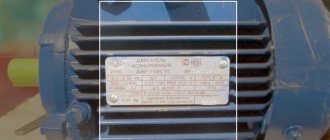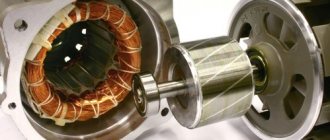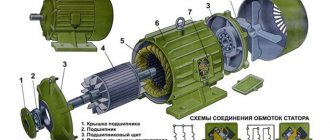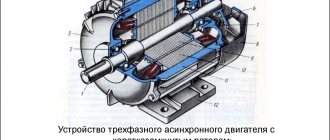Soft start devices (Soft starters) are designed for smooth acceleration and deceleration of electric motors, limiting inrush currents at the time of start-up and matching the load torque with the engine torque.
It is no secret that asynchronous motors, when starting, have high starting currents, exceeding 6-8, and in some cases even 10 times, the rated current and a significant increase in torque, which negatively affects the operation of the motors themselves. In addition, this leads to a voltage drop in the supply networks, which in turn affects the operation of other electrical equipment.
There are several options to solve this problem. Most often, this is done by connecting the motor according to the “Star-Delta” scheme, through soft starters and frequency converters. In this article we will consider only UPP, but I will briefly talk about the other two options.
Starting according to the star-delta circuit is carried out as follows - during the initial period of engine acceleration, its windings are connected by a star, which provides a reduced current. After a certain time set by the time delay relay, it switches to delta, which provides full current and torque.
This method is effective when starting the engine either without load or with an easy start. When starting the engine under heavy load, this method is not applicable. Also, this circuit can only be used with motors whose windings are designed for a mains voltage of 380/660V.
The use of frequency converters makes it possible to ensure that the engine will already operate at the rated current and with the rated torque at the moment of starting. Also, the use of a frequency drive allows for a smooth stop of the engine, in contrast to the star-delta circuit, where the only way to stop can be direct stop.
The use of a frequency converter is justified in cases where motor speed control is required. If regulation is not required, then the optimal solution would be to use soft starters.
Thanks to these devices, it is possible to avoid problems associated with starting, ensure a smooth start of motors with limited starting current and angular acceleration, and adjust the engine acceleration and deceleration time. All this helps to increase the service life of equipment and stabilize voltage in networks.
In addition, a number of different protection functions are built into soft starters -
- Protection against loss of input phase and output phase
- Phase imbalance protection
- Motor overload protection
- Undervoltage and overvoltage protection
- Load short circuit protection
Despite the fact that soft starters are produced by a large number of different manufacturers and each has its own characteristics, the general principle of operation of the device is the same for all. And it consists in regulating the effective value of the output voltage.
At the moment the electric motor starts, the soft starter limits the supply voltage (30 - 60% of the rated voltage), then gradually increases it to the rated value. At the same time, the starting current and the rate of its increase are reduced, and the engine starting time increases. This type of start also allows you to reduce the starting torque on the shaft.
Just like frequency converters, soft start devices allow for a smooth stop of the engine, which in turn helps prevent water hammer in water supply systems, damage to materials on belt conveyors, etc.
Design and principle of operation of soft starters
Regulation of the effective voltage value is carried out using thyristor modules, which in turn are controlled by a microprocessor located on the control board. Depending on the type of soft starter, the voltage can be adjusted in two phases; usually, such a scheme is implemented in more budget options, or in three phases.
In the first case, counter-directional thyristors are installed in the first and third phases - two each. One of the thyristors is designed for the positive half-cycle, the second for the negative. In the third phase, which is conventionally called uncontrolled, the current value is equal to the sum of the current values in the first two phases (controlled). With this scheme, the voltage of one phase will be present on the motor all the time.
More functional is voltage regulation in three phases. In this case, you can build various acceleration curves, control torque, and implement an energy saving function.
When starting, the signal arrives at the thyristors in such a way that only the last part of each half-cycle of the sinusoidal voltage passes. Then the signal arrives earlier and earlier, in accordance with the set acceleration time, and more and more voltage will pass through the thyristors. In the end, the signal is sent exactly after passing zero, after which the full voltage passes through the thyristors. After acceleration, the thyristors are in the open state, and the mains voltage comes to the motor terminals.
During a soft stop, the reverse process occurs. Initially, the thyristors transmit full voltage, and when the shutdown begins, they reduce it in accordance with the set time.
In addition to the thyristor modules and control board, the soft starter may also have a built-in overload relay, measuring current transformers, thermistor protection, display and keyboard, radiator and fans, and communication interfaces.
Many soft starters have a built-in bypass contactor in the main circuit, which is generally a distinctive feature of this type of device. If a built-in bypass is not provided, it is recommended to use conventional external contactors.
A bypass is a bypass, bypass path created to bypass certain sections or elements of the electrical circuit.
The bypass contactor is used to connect the motor directly to the mains supply at the end of the startup process, after the soft starter accelerates the motor to rated speed and there is no longer a need for it. When braking, the contactor is switched off and the motor is reconnected to the soft starter.
This scheme is due to the fact that during operation of the soft starter, its power elements, in particular thyristors, become very hot, which leads, firstly, to the release of heat, which must be dissipated somewhere, and secondly, to their premature failure . You can, of course, use an additional heat sink (radiators, fans), but this leads to an increase in overall dimensions and price. And since a soft starter is needed only at the moment of starting, it turns out that it will be easier to take it out of operation while the engine is operating in nominal mode.
Homemade options
There are many schemes for modernizing power tools using soft starters. Among all varieties, devices based on triacs are widely used. A triac is a semiconductor element that allows you to smoothly regulate power parameters. There are simple and complex circuits that differ in design options, as well as in the supported power of the connected power tool. The design includes internal ones, which allow them to be built inside the case, and external ones, manufactured in the form of a separate module, which acts as a speed limiter and starting current when starting the angle grinder directly.
The simplest scheme
A soft starter with speed control on a thyristor KU 202 is widely used due to its very simple design (diagram 1). Connecting it does not require any special skills. Radio elements for it are very easy to obtain. This regulator model consists of a diode bridge, a variable resistor (acts as a U regulator) and a thyristor tuning circuit (supplying U to the control output with a nominal value of 6.3 volts) from a domestic manufacturer.
Scheme 1. Electrical diagram of the indoor unit with speed control and soft start (electrical circuit diagram)
Due to the size and number of parts, this type of regulator can be built into the body of a power tool. In addition, the variable resistor knob should be removed and the speed controller itself can be modified by integrating a button in front of the diode bridge.
The basic principle of operation is to regulate the speed of the electric motor of the tool by limiting the power in manual mode. This circuit allows you to use power tools with a power of up to 1.5 kW. To increase this indicator, it is necessary to replace the thyristor with a more powerful one (information about this can be found on the Internet or in a reference book). In addition, you need to take into account the fact that the thyristor control circuit will differ from the original one. KU 202 is an excellent thyristor, but its significant drawback is its configuration (selection of parts for the control circuit). To implement a soft start in automatic mode, scheme 2 is used (soft starter on a microcircuit).
Soft start on a chip
The best option for manufacturing a soft starter is a soft starter circuit with one triac and a microcircuit that controls the smooth opening of a pn type transition. The device is powered from a 220 V network and is easy to assemble yourself. A very simple and universal soft start circuit for an electric motor also allows you to regulate the speed (diagram 2). The triac can be replaced with the same one or with characteristics exceeding the original ones, according to the reference book of semiconductor-type radioelements.
Selecting a soft starter
When choosing a soft starter, the determining factors are the rated current of the motor and the starting conditions.
For easy and normal starting, for example, when working with centrifugal pumps, compressors, the power of the soft starter is selected to be the same as the power of the connected motor, perhaps with a small margin.
For heavy starting under load, or increased frequency of starts, it is advisable to choose a more powerful soft starter, one size larger. This also applies to the operation of devices under severe operating conditions, in particular at elevated ambient temperatures.
An increased launch frequency is considered to be more than 10 launches per hour.
This rate is influenced by several factors such as load current, temperature, start-up time, and duty cycle factor, which determines how long the starter operates compared to the total cycle time.
The table below shows the starting modes, depending on the type of load. This data is suitable for preliminary selection, for a more accurate selection of equipment, I recommend using configurator programs for selecting soft starters, such as ABB ProSoft, or Win-Soft Starter for Siemens.
